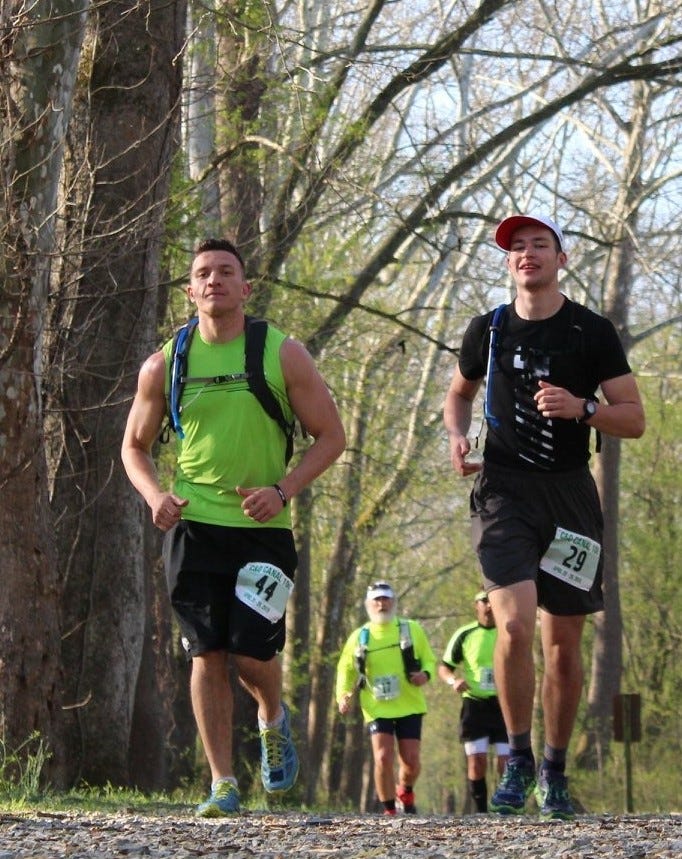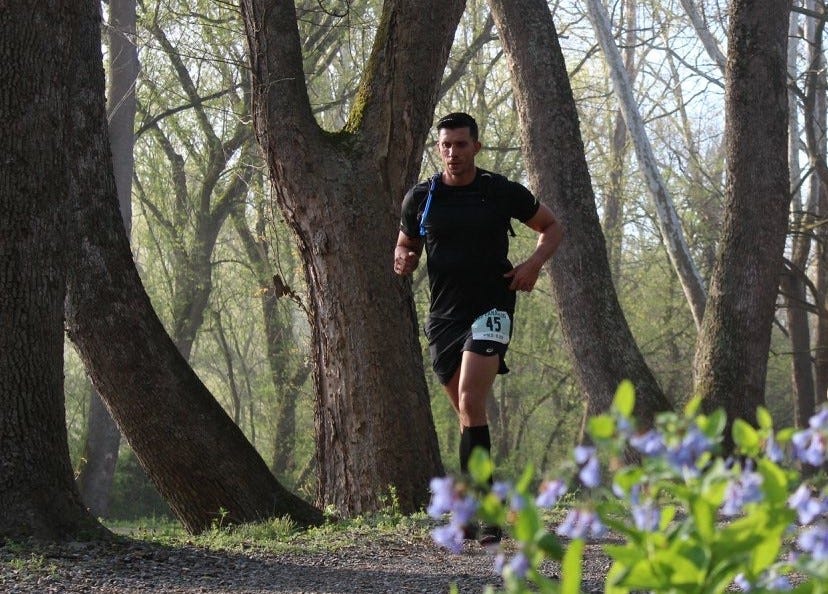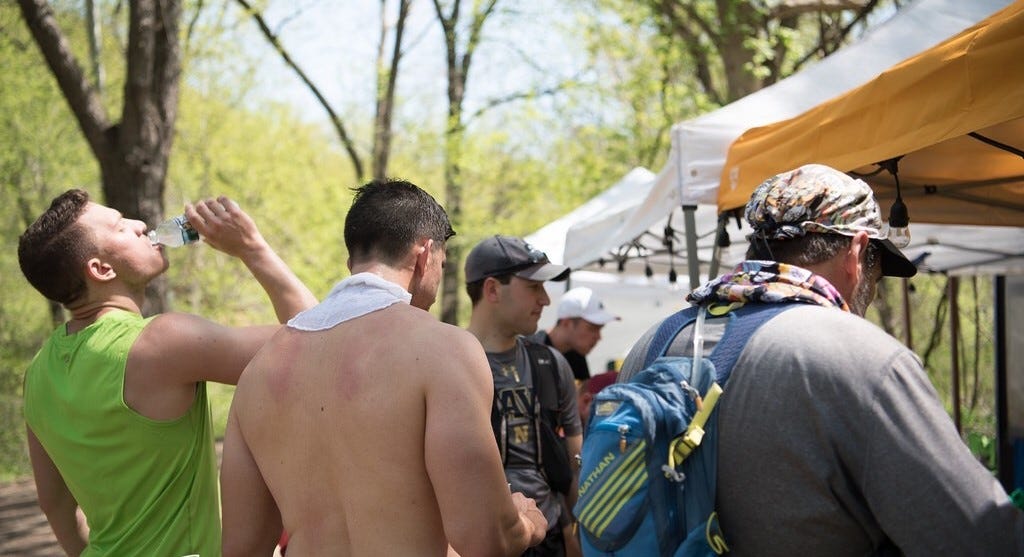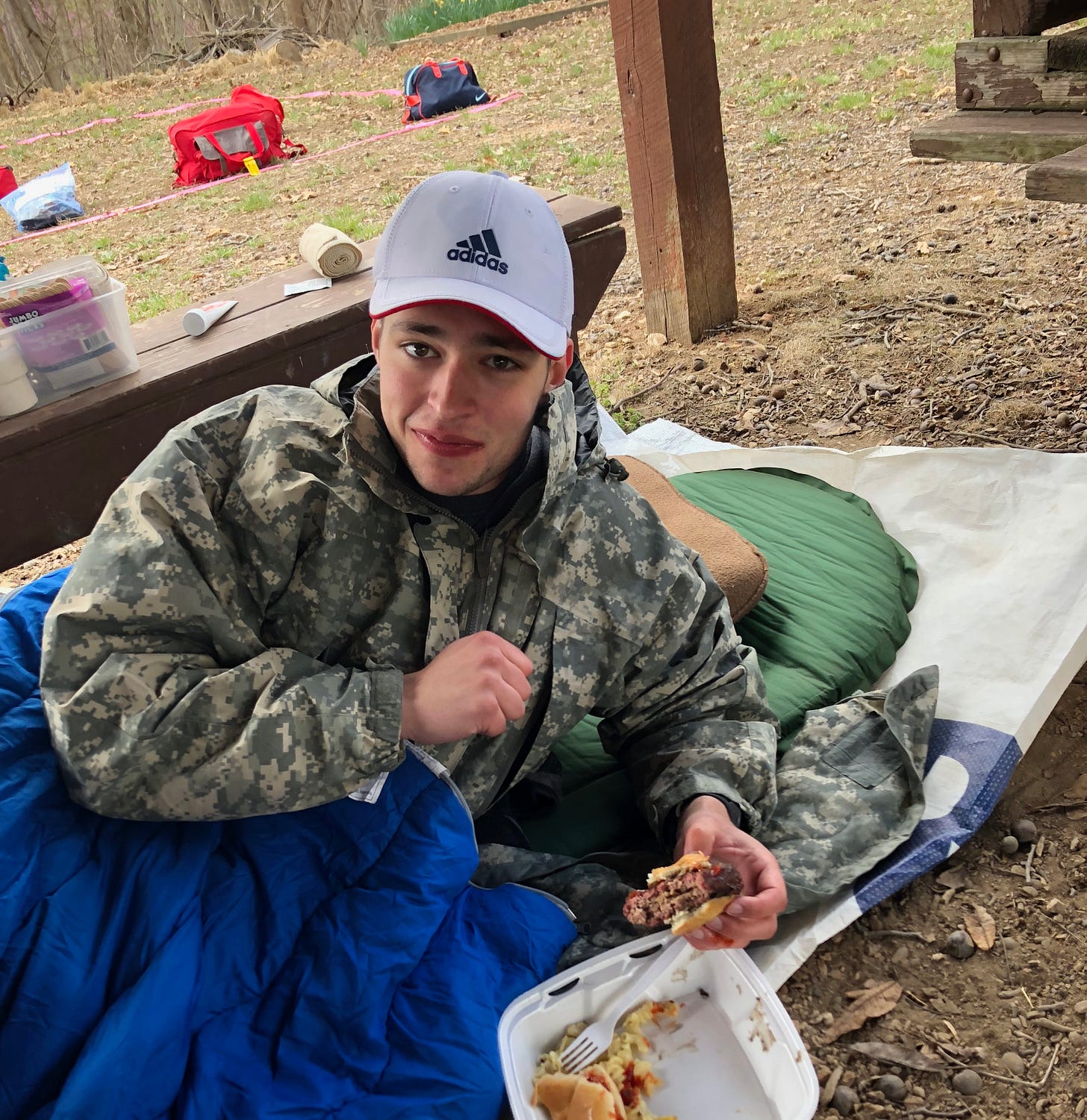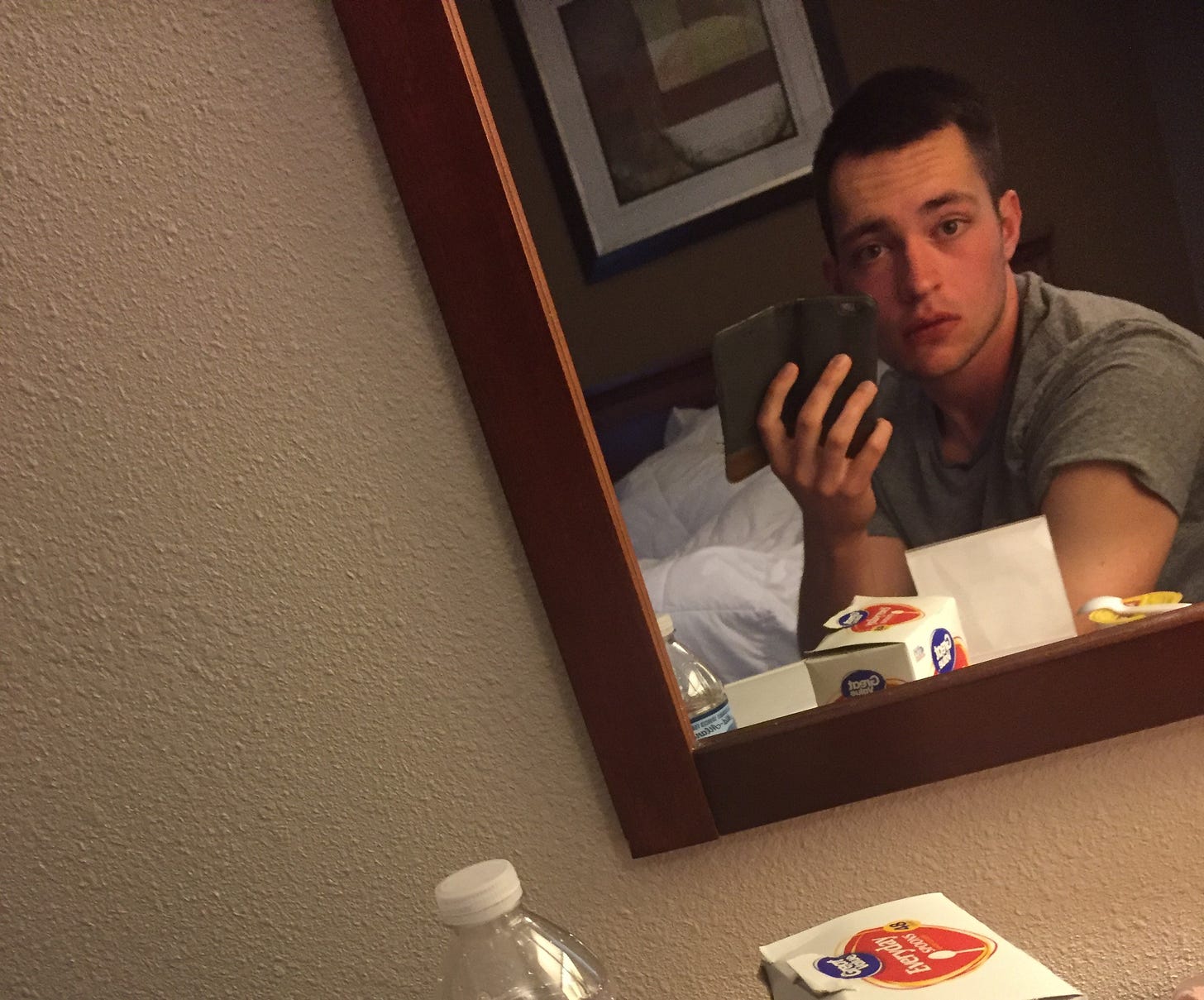Race Report: 2018 C&O Canal 100 Miler
This story begins where no good story has started before: I’m in my Geographic Information Systems professor’s office, looking desperately for a way out. My project, which mapped the elevation change of the infamous Pitchell, a 67 mile run from the top of Mount Pisgah to Mount Mitchell, was not impressing.
Yeah, that’s all I have.
And you’re sure you don’t want to present?
Yes.
Ok, you can go.
I nearly sprinted out of there. It was exam week at university, and somehow my professor had granted me permission to leave the day before my presentation. A week prior, I had competed for the first time in powerlifting. Now I was ditching exams to run my second 100 mile race. It goes without saying: I was not taking school seriously at this point (sorry mom).
The C&O Canal is a flatter 100, up near Annapolis, where my friends, John and Louis, were meeting Mickey to run the Canal. “Mick” was a friend of John’s, and Louis, John’s older brother, was not interested in running with us to begin with. The plan was for him to take off while John, Mick, and I would act as a sweep if things went wrong. John and Louis are brothers, and their mother bravely signed up to crew for all four of us.
Two things struck me about Louis: first, on the drive up to the race, he insisted we listened exclusively to podcasts from special forces veterans. Topics included the Rwandan Genocide, the Cambodian Genocide, and the worst war stories from Iraq I’d ever heard. Like my professor's office, I was trapped again, looking desperately for a way out. 8 hours later, I got out of the car firmly depressed about the state of humanity. Second was his training: John and I had half-assed buildups, each working up to a 26 mile long run over 4-5 weeks, but Louis had not trained a single step. He also had no hundred mile experience, which John and I had. His plan to run ahead of us was one of the lowest IQ moves in the history of ultramarathon running.
The race started with a gunshot, and Louis took off sprinting at a 6 minute mile pace. It was inspirational stuff. 200 meters in, he took the lead, edging ahead of runners half his size. With the lead pack, he disappeared into the woods, leaving me, John, and Mick to trot along at our easy pace.
The C&O Canal starts at Camp Manidokan, dips through under a half mile of steep trail, then continues 10 miles along the Potomac River towpath to the first turnaround. The runner then goes 30 miles down to the other turnaround, before going 20 miles back to camp for 60 miles. After 60, the runner then goes back and does 20 miles to the second turnaround (80) before coming back home with a total of 100 miles. If that’s confusing, just remember that we expect to see runners heading in the other direction with the long out-and-backs.
Given this, Mickey, John and I expected to see Louis as we approached the 10 mile turnaround. We were doing a disciplined walk/run split at the back of the pack. The lead runners were heading in the opposite direction. As we got closer and closer to the turnaround, we realized Louis wasn’t as far ahead of us as we first thought. At mile 9, and 11 for him, we saw him coming the other way. There was a man drenched in sweat, his feet barely leaving the ground. His eyes had the classic thousand yard stare of a man in the deepest recesses of his mind. I had never seen someone look this bad this early in a race before. He hardly acknowledged us as we passed, only craning his neck slightly to see us, before slowly placing his gaze back on the road before him.
At the turnaround, John was clear.
Slow. Down.
We don’t want to catch him this early. Not yet.
We were 10% in and already revising the plan. Sure - we expected to catch Louis - but not this early. Mickey and I slowed to John’s request, but by mile 14 we had caught up. If there were any doubts about Louis’ claim to running 0.0 miles in preparation, this was the end of them. He was too exhausted to say much as we picked him up, though he did latch on to our walk/run schedule. As the nerd of the group, I had a printed Excel spreadsheet that I pulled out of my CamelBak and checked periodically. I had written for us to finish in 28 hours, accounting for slow-down and time spent at aid stations, with a two hour contingency for shit to hit the fan before the 30 hour cutoff. Unfortunately, John, a complete luddite, had decided not to bring a watch. Every five minutes he asked me what time it was as I calculated in my head how to keep us on track.
I had neglected to mention until now that it was Mick’s first 100 and John and I had come up to help him get his first buckle. Louis had jumped into the lineup for some last minute fun, but also had not yet attempted a 100. As the day heated up to around 85 degrees we continued our march down the Canal. At some point Louis lost his shirt, though I didn’t bother to ask where it went. At mile 30 his struggling had visibly increased, and he would fall behind the pace before running to catch up with us. I would check my watch and announce walk or run depending on our split. Mick looked great - as did John - and I was almost entirely focused on keeping us all on track to think much about myself, though I felt strong.
At the mile 40 turnaround, I began to feel the familiar pulling feelings in the back of my hamstrings from walking 40 miles. The deep soreness was exacerbated by my deadlift PR a week ago. However, our pace was slow, and I had no problem beginning the return to Manidokan Camp. Louis, however, was a different story. His gait no longer cleared the gravel towpath beneath his feet. Each step he took kicked up gravel, sand, and dirt. Looking behind him, there were two rows of displaced earth, as if someone with wide skis had scooted along the towpath, for as long as I could see. Louis was definitely not skiing. The extra exertion to tunnel through the towpath compounded the effort required to keep moving. He was beginning to drop further and further behind before doing a resurgent sprint to catch up with us. At mile 48, shortly before the halfway aid station, as Mick and I were joking around, when I noticed John welling up. A few tears were already rolling to the ground
The sun was starting to set, and this is normally when I get weird and emotional. But John? No way. John spoke:
At least he made it to 50. He did a no-training 50 miler.
I looked behind John. In the setting light, Louis was nowhere to be seen. It was clear we’d left him far behind. I could offer no consolation to John about his brother. He wanted Louis to make it as much as himself. Without much discussion we agreed that we would wait at the 50 mile marker to hand off Louis to the crew (his mother). We continued in solemnity for about two minutes.
Suddenly, through the dying sunset, a figure formed through the darkness. Shirtless, head down, and fully sprinting. It was Louis. He blew by us and did not offer us the slightest acknowledgement; he was more animal than human at this point. My best description of the look in his eyes is this: earlier at University, just outside the dining hall, a group of vegan activists accosted me and forced a VR headset over my eyes. A man lowered a pistol and shot a cow in the head at point blank. There was a deep animalistic terror in the animal’s eyes. Blood poured from the wound; swimming pools of blood and metal hooks carried carnage in a vast slaughterhouse. I still don’t eat beef. The look that cow had – the open horror of inevitable, infinite death – is the closest description I have for the look I saw at the C&O Canal. That’s about where Louis was at mile 50.
Upon the sight of his brother, John put his head in his hands.
Oh God… he shook his head. He had the conviction that his brother was going to kill himself. As we inevitably caught up, John collected himself, not letting Louis see his emotional state. Just as darkness began to take over we made it to 50 miles. I checked my watch: we had made it halfway in 11:48. We were flying. John remarked how easy 50 miles was. Upon hearing the time remaining, the human side of Louis re-emerged slightly as he did some back-of-notebook calculations in his head as to how he might finish. Most optimistic of all was Mick.
I’m going to run ahead. I’ll see you guys later.
John was nonchalant.
Go on! We’ll be behind you.
I was wary, but who were we to deny this man? He looked great and John and I prepared to catch him should he fall behind, so we let Mick go ahead with our good graces. Our pace slowed significantly from 50-60. Somewhere in that segment Louis’s back-of-notepad calculations came in: there was no good reason for me to have dragged him to a sub 24 hour pace 50 miler. For a man so far gone, he collected himself to present some of the most creative insults I’d ever heard. We were hours ahead of the plan, so I was the cause of a lot of his pain. Fair play. His volleys of abuse kept us entertained until mile 60. As we approached the climb to Manidokan we saw Mickey running the other way. He looked more fatigued than before but was making good time.
We spent about a half-hour at base camp in Manidokan while Louis received medical care from our crew. The following stretch to mile 70 brought a series of strange occurrences: I met another runner who said they were using the C&O Canal as a warm up for the Devil Dog 100. At 70, they quit. A point of advice: treat a 100 miler with respect or that will happen to you. Conversely, coming the other way, we witnessed Victor, a 19 year old from the Naval Academy coming through to win in 18:13. John knew him – and for a moment I forgot I was in the race at all as I turned to cheer him on. It was a great respite. Some time after Victor, a slight, older runner in a cotton vest, shorts, and sandals, with no water or nutrition came down the road. Louis - who had descended back again into a feral state, began to speak to him in Russian. The man did not know any English and subsisted only on aid station food and water in what was becoming a cold night. Why did he register? Was this just a walk in the park for him? Did he train – and did he wear those sandals? I was puzzled, in awe of this man, and never saw him again.
Our experience from mile 70 to 80 - 80 being the turnaround to go back to the finish for 100 - was less whimsical. Given how much we’d slowed, John and Louis became concerned about the cutoffs, which we weren’t sure of. It had also started to rain and the temperature dropped to 42 degrees. I had a sweater and a beanie. John had a cutoff shirt. Louis was shirtless, and yes, hypothermic. We saw a runner crumpled on the side of the road in a shape I’d never seen a human contort to before. They were quietly sobbing, their limbs coming above their body like a dead spider on its back. We passed by without disturbing them.
With each step my confidence in us finishing increased. An aid station volunteer informed us we had plenty of time with the cut-offs. But as we approached the mile 80 turnaround there was no sign of Mickey coming back the other way. Once we were a mile out we knew something had gone seriously wrong. John and Louis sent me ahead to the aid station. If he was there I could rally him and we could march home together. However, I feared the worst. You know when you wish you’d said something, and you know there’s never a chance to say it again? I wish I’d emphasized to Mickey at mile 50: don’t quit. We’ll be there. I arrived at 80, uninterested in aid, yelling for Mickey. We missed him by 7 minutes. The aid station volunteers had just escorted him back to the start. Apparently, he’d collapsed on the trail, one mile from the turnaround, crying, and had to be coaxed to the aid station. As much as the volunteers pleaded, he quit in the chair before we had a chance to get to him. Done.
We left the mile 80 aid station at 21 hours and 40 minutes. 8 hours to go 20 miles: we could walk it home doing 24 minute miles and still finish. The light rain had passed, but it would be a cold even when the sun came up. Louis and John began to shiver, but I was cozy in my sweater and beanie. Up until this point, I haven’t spoken much about myself - because until this race was never really about me. I had offered my best services to help the two brothers along: timing, pacing, support. But we were all here to help Mickey finish his first 100. With that goal out of the window, and Louis in striking distance, my job was done. I had to open up my legs and run. At around 81, I took two ibuprofen to unlock my fatigued legs. As I fumbled with my headphones, which I hadn’t used until this point, I realized I dropped my bag of meds. As I walked back to retrieve them off the ground, I realized a woman named Tek, who was behind us approaching the mile 80 aid station, was sobbing. She was in severe pain - so I offered her a couple Ibuprofen. She accepted them.
Leaving Louis and John was a paradox - I was inspired by the immense effort of Louis and wanted to enter the fray as well- suffer and run my own race. And yet, I did not want to abandon my companions in the final leg. My issue was resolved when John passed me his dead phone. He needed some music, so I was to get to the next aid station as fast as possible so his mother (one-man-army crew) could charge it. He also requested warm clothes for him and Louis. I put in my headphones and took off, arriving at the aid station doing 9:30 miles. John and Louis hadn’t packed any warm clothes, so I took off my sweater, beanie, and gloves, and volunteered my post-race attire for use now. It was light again, so I switched back to my trusty baseball cap and kept running.
Over the next 14 miles I would pass 21 runners to the finish. I figured my mother was worried about me, so at the mile 93 aid station I called her and said I was going to finish the race. I felt like the dude who called his father shortly before winning Who Wants to be a Millionaire?. I pushed as hard as I could the final miles and tried to sprint up the 150 meter hill to the finish. A crowd of people assembled at the top, cheering me on. I didn’t sustain the pace, and when I reached the top and finished, I paused for a moment, standing still. As I caught my breath, my knees began to buckle. A volunteer came over and caught me and I hugged him tightly. Bill, it looks like you have a new son!, another volunteer yelled to a round of joyous laughter. John’s mother was not yet at the finish line, so the volunteers took care of me and stuck me in a sleeping bag to rest.
26:35:06 finish. After a few hours of laying down, I started to get anxious. Where were John and Louis? There was only an hour and a half to finish. John’s mother soon arrived at the finish line and brought me food. I was good - of course I could hardly walk, and was languishing on the floor, but runners were finishing in much worse condition than I was. Slowly, we collected around a measly fire and swapped tales of our run. One runner said me passing him from mile 80 was the best he’d seen anyone at that stage of a race. I was a bit sheepish accepting that compliment - I was essentially a pacer for 80 miles and only started running a few miles before that.
29:00:00. One hour for John and Louis to finish. Normally at this point in Ultras, things start to wind down. Volunteers pack up camp and aid crews go home with their runners as they complete the race. However, a sizable crowd remained at the finish of the Canal: buckles are withheld until the end of the event, which I credit the race director for. No one leaves happy until we are all home.
29:30:00. My confidence that John and Louis would finish in time was starting to wobble. John’s mother and I looked at our watches every thirty seconds. She saw them first - three runners - at the bottom of the hill. They were going to finish. And with them was Tek - the woman I had given a few Ibuprofen to who was miles behind us! John and Louis ushered her to go ahead and finish ahead of them, which she did. John and Louis walked across the line moments after to ceremonious applause. Word had gotten out that two brothers were still out on the course and people liked that. Both of them were shirtless, and Louis had pinned his race bib through the skin on his chest. My eyes couldn’t process what I was looking at.
Is that going through your skin?
John interjected: Don’t ask him any questions. He’s volatile.
Louis ignored me, pulled the pins out (answering my question) and we posed for a photo at the finish line. Job done.
The medal ceremony was swift - we were congratulated by Victor, who had stuck around after winning over 10 hours earlier, and his pacer. There is no special prize for winning at the Canal: everyone gets the same thing. As we prepared to leave, it dawned on me: If John and Louis finished shirtless, where were my clothes that I left them?
At the bottom of the hill.
What?
Not the small hill. A mile down the road.
In the history of the Canal, I must be the only sorry asshole who had to trek back down the only serious climb of the race, across the stream crossing, collect their shit, and come back up after finishing the race. On my way down, I saw a man in his 60s, Dan, an hour off of the cutoff, finishing the course. His pacers were somber and quiet. A herculean effort was underway, but the ultimate goal had been missed. This was Dan’s 3rd consecutive DNF, and he would go on to DNF again in 2019. I quietly passed them again on the way back up.
We returned to the hotel. I took a selfie to document the occasion. The plan was to sleep for a night before heading home as none of us had slept. This is what I looked like (shit).
As strung-out as I was, John, and particularly Louis, were worse. It took an hour for each of them to shower, most of which was spent traveling 10 steps from the beds to the bathroom. For hours after, they lay in bed, needing care from their mother. A horrible cough overcame Louis that Sunday. He called out:
Mamaaaaaa…
His arm was hanging out from the side of the bed. He was half conscious.
Mamaa….
He had to pee. A 32 year old man. His mother - more nurse than crew - helped him up for the long walk to the bathroom. This was the level of devastation we were at.
I returned to school soon after my adventure at the Canal in decent shape, except for my grades. Anonymous comments on my Pitchell project were delivered to me on notecards.
Low Effort!
Another comment:
Pointless…?
Ouch. People are harsh.
John called me a few days after the race. He was healing faster than Louis and they both didn’t have any long-term damage. Quick note about ultras: no one ever does. We reminisced: at 50 miles and 12 hours Louis was dead and buried. The next 50 would take him 18 hours at a 22 minute mile pace. Compare that experience with mine or, god forbid, Mickey’s. I haven’t been back to check, but there are probably still two trenches in the CO Canal towpath where Louis dragged his feet through 50 miles of gravel.
In the end that’s what it’s about - the unlikely finishers. The underprepared. The shirtless dude in freezing rain at mile 75. John’s anguish about his brother’s much rumored demise at mile 50. Standing on the start line of an ultra there’s a communal feeling that for the next 30 hours anything can happen. After? It’s the recognition that the truest distillation of human spirit - effort - isn’t taught in a classroom or on ESPN. It’s somewhere far from home, in a little-known race that’s $150 to enter. It’s simultaneously two brothers over 200 pounds marching in a no-training finish, and Tek, a woman who had cried her eyes out the last 20 miles and driven herself across the line in time. After seeing that; finishing with those people, everything else is trivial.
Alex




